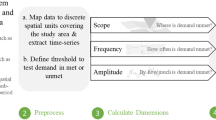Abstract
Models are used in many policy arenas to predict the future consequences of current decisions. A model is typically viewed as a rational, objective means of processing complex information to predict future conditions. With respect to socioeconomic modeling, policy scientists have found that models frequently do not live up to these promises – they often incorporate the modelers' biases, are difficult for decision makers to use, and do a poor job of point predictions. While awareness of these characteristics of socioeconomic models has increased, less attention has been paid to such factors in environmental modeling. This paper explores the implications of policy scientists' observations about socioeconomic models for the use of water quality models environmental decision making. For example, the relatively simple task of modeling for an estuarine waste load allocation decision incorporates judgment in model choice, calibration, and use. More complex watershed models involve even more choices that have implications for decision making. Thus, environmental models are not strictly technical inputs to the policy process. Model users, regulators, and the public should be aware of the judgments and uncertainties involved in surface water quality modeling so that model results are used appropriately in the decision-making process.
Similar content being viewed by others
References
Ascher, W. (1978). Forecasting: An Appraisal for Policy-makers and Planners. Baltimore, MD: Johns Hopkins University Press.
Ascher, W. (1981). ‘The forecasting potential of complex models,’ Policy Sciences 13: 247–267.
Ascher, W. (1985). Background Paper on Forecasting and Governance. Washington, DC: National Academy of Public Administration.
Ascher, W. and W.H. Overholt (1983). Strategic Planning and Forecasting: Political Risk and Economic Opportunity. New York, NY: John Wiley and Sons.
Beck, M.B. (1987). ‘Water quality modeling: A review of the analysis of uncertainty,’ Water Resources Research 23(8): 1393–1442.
Biswas, H. (1990). Technical Guidance Manual for Performing Waste Load Allocations - Book III: Estuaries. Washington, DC: USEPA Offce of Water.
Brewer, G. (1973). Bureaucrats, Politicians, and the Consultant. New York, NY: Basic Books.
Brown, G. Jr. (1992). ‘Commentary.'American Journal of Physics 60(9): 779–781.
Brunner, R.D. and W. Ascher (1992). 'Science and social accountability,'Policy Sciences 25: 295–331.
Castleberry, D.T., J.J. Cech Jr., D.C. Erman, D. Hankin, M. Healey, G.M. Kondolf, M. Mangel, M. Mohr, P.B. Moyle, J. Nielsen, T.P. Speed, and J.G. Williams (1996). ‘Uncertainty and instream flow standards,’ Fisheries 21(8): 20–21.
Creager, C.S. and J.P. Baker (1991). North Carolina' Whole Basin Approach to Water Quality Management: Program Description. Raleigh, NC: North Carolina Department of Environment, Health, and Natural Resources.
Cowling, E.B. (1992). ‘The performance and legacy of NAPAP,’ Ecological Applications 2(2): 111–116.
Dennis, R.L., M.W. Downton, and P. Middleton (1984). ‘Policy-making and the role of simplified models: An air quality planning example,’ Ecological Modelling 25: 1–3.
Dillaha, T. A. (1990). ‘Role of best management practices in restoring the health of the Chesapeake Bay: Assessments of effectiveness,’ in Perspectives on the Chesapeake Bay, 1990: Advances in Estuarine Sciences. Gloucester Point,VA: Chesapeake Research Consortium.
Doppelt, B., M. Scurlock, C. Frissell, and J. Karr (1993). Entering the Watershed: A New Approach to Save America' River Ecosystems. Washington, DC: Island Press.
Downs, G.W. and P.D. Larkey (1986). The Search for Government Effciency: From Hubris to Helplessness. Philadelphia, PA: Temple University Press.
Evans, P.B. (1994).The Clean Water Act Handbook. Chicago, IL: American Bar Association.
Fischer, F. (1993). ‘Policy discourse and the politics of Washington think tanks,’ in F. Fischer and J. Forester, eds., The Argumentative Turn in Policy Analysis and Planning. Durham, NC: Duke University Press.
Freeman, A. M. III (1990).'Water pollution policy,' in P.R. Portney, ed., Public Policies for Environmental Protection. Washington, DC: Resources for the Future.
Greenberger, M., M.A. Crenson and B.L. Crissey (1976). Models in the Policy Process: Public Decision Making in the Computer Era. NewYork, NY: Russell Sage Fountain.
Grumbine, R.E. (1994). ‘What is ecosystem management?’ Conservation Biology 8: 27–38.
Haan, C.T., J.B. Solie and B.N. Wilson (1990). ‘To tell the truth - hydrologic models in court,’ in E.J. Janes and W.R. Hotchkiss, eds., Transferring Models to Users. Bethesda, MD: American Water Resources Association, pp. 337–348.
Hammond, P. B. (1984). ‘The energy model muddle,’ Policy Sciences 16: 227–243.
Harbor, J. M. (1994). ‘A practical method for estimating the impact of land-use change on surface runoff, groundwater recharge, and wetland hydrology.’ APA Journal Winter: 95–108.
Lee, K.N. (1993). Compass and Gyroscope: Integrating Science and Politics for the Environment. Washington, DC: Island Press.
Levitas, S.J. and D.N. Rader (1992). ‘Point/nonpoint source trading: A new approach to reducing nutrient pollution,’ Environmental Permitting Winter: 5–19.
Linker, L. (1995). Chesapeake Bay Program Modeling Coordinator, EPA Chesapeake Bay Program Offce, Annapolis MD. Personal Communication November 8, 1995 and March 20, 1996.
Lovejoy, S.B. (1997). ‘Watershed management for water quality protection: Are GIS and simulation models THE answer?’ Journal of Soil and Water Conservation 52(2): 103.
MacKenzie, S.H. (1996). Integrated Resource Planning and Management: The Ecosystem Approach in the Great Lakes Basin. Covelo, CA: Island Press.
McMahon, G. III (1995). The Role of Information in Watershed Planning: Contributions of Critical Theory and Environmental Dispute Resolution. Doctoral Dissertation. Chapel Hill, NC: The University of North Carolina.
Office of Technology Assessment (1982). Use of Models for Water Resources Management, Planning and Policy (Summary). OTA–0–160.Washington, DC: OTA.
Oreskes, N., K. Shrader-Frechette and K. Belitz (1994). ‘Verification, validation, and confirmation of numerical models in the earth sciences,’ Science 263: 641–646.
Osmond, D.L. R.W. Gannon, J.A. Gale, D.E. Line, C.B. Knott, K.A. Phillips, M.H. Turner, M.A. Foster, D.E. Lehning, S.W. Coffey and J. Spooner (1997). ‘Watersheds: A decision support system for watershed-scale nonpoint source water quality problems,’ Journal of the American Water Resources Association 33(2): 327–341.
Patrick, R. (1992). Surface Water Quality: Have the Laws Been Successful? Princeton, NJ: Princeton University Press.
Pielke, R.A. Jr. (1995). ‘Usable information for polilcy: An appraisal of the U.S. Global Change Research Program,’ Policy Sciences 28(1): 39–77.
Reckhow, K. H. and S.C. Chapra (1983). Engineering Approaches for Lake Management. Volume 1: Data analysis and empirical modeling. Boston, MA: Butterworth Publishers.
Reckhow, K.H., J.B. Butcher and C.M. Marin (1985). ‘Pollutant runoff models: Selection and use in decision making,’ Water Resources Bulletin 21(2): 185–195.
Smith, K. L. (1992). Report on the Usage of Computer Models of Estuaries by Eastern Coastal States. Special Report Series No. 10. Raleigh, NC: Water Resources Research Institute.
Strom, D. (1982). ‘Improving environmental programs through public policy models,’ Environment 24(10): 26–29.
Thomann, R.V. (1990). ‘Expert critique of case studies,’ in H. Biswas, ed., Technical Guidance Manual for Performing Waste Load Allocations - Book III: Estuaries.Washington, DC: USEPA Offce of Water, pp. 12–1–12–10.
Thomann, R.V. and J.A. Mueller (1987). Principles of Surface Water Quality Modeling and Control. NewYork, NY: Harper and Row.
Thornton, K., C. Stalnaker and K. Baun (1990). ‘Problems with surface water models from a user' perspective,’ in D.G. Decoursey, ed., Proceedings of the International Symposium on Water Quality Modeling of Agricultural Non Point Sources. Utah State University. Logan, UT: Agricultural Research Service Publication ARS-81. USDA, pp. 450–455.
USEPA (1988).WASP4, A Hydrodynamic and Water Quality Model - Model Theory, User' Manual, and Programmer' Guide. Athens, GA: Environmental Research Laboratory.
Walker, W.E. (1981). ‘Models in the policy process: Past, present, and future,’ a paper presented at the Tenth IFIP Conference on system modeling and optimization, New York, NY: August 31- September 4.
Weiss, C.H. (1977). Using Social Research in Public Policy Making. Lexington, MA: Lexington Books.
Author information
Authors and Affiliations
Rights and permissions
About this article
Cite this article
Smith Korfmacher, K. Water quality modeling for environmental management: Lessons from the policy sciences. Policy Sciences 31, 35–54 (1998). https://doi.org/10.1023/A:1004334600179
Issue Date:
DOI: https://doi.org/10.1023/A:1004334600179




